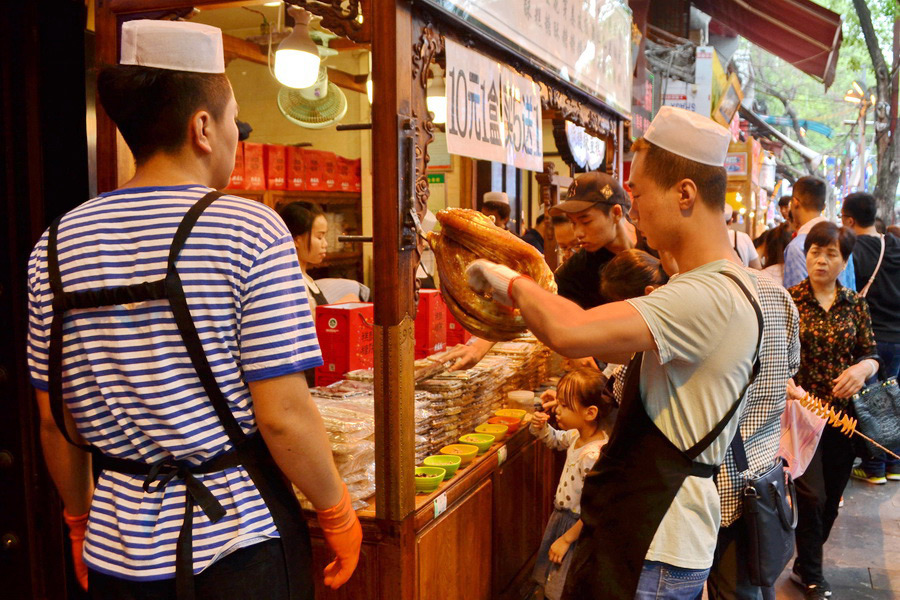
The Muslim Quarter of Xi'an, also known as Huimin Jie in Pingyin, is the heart of the old city and among its most vibrant areas. For centuries, trade routes converged here, blending the traditions and languages of East and West. Behind the imposing Drum Tower, narrow lanes lead to ancient mosques and lively rows of shops, where the chatter of vendors never ceases and the air is rich with the scent of spices. This district is a landmark of the Silk Road, which began here.
A guide to the Muslim Quarter will help you capture its unique atmosphere, navigate its most fascinating streets and alleys, discover the signature dishes of local cuisine, and select memorable souvenirs. As you plan a stroll through this historic neighbourhood, you will uncover yet another dimension of Xi'an’s multifaceted character.
Muslim Quarter of Xi'an Tours

A tour of the Muslim Quarter offers a glimpse into the daily rhythms of old Xi'an. Here, you can admire intricately carved house facades, visit the majestic Great Mosque of Xi'an – one of the oldest in China – and breathe in the scent of spices and sweets that fills the air. A stroll through the local market is a treat for fans of oriental street food, with spicy kebabs, steaming soups, crispy persimmon pies, and an endless variety of desserts to suit every palate.
A walk through the Muslim Quarter is a highlight of every Advantour tour to Xi'an. Discover the charm of one of the city's most distinctive neighbourhoods by joining a multi-day adventure across China:
Best Time to Visit the Muslim Quarter of Xi'an
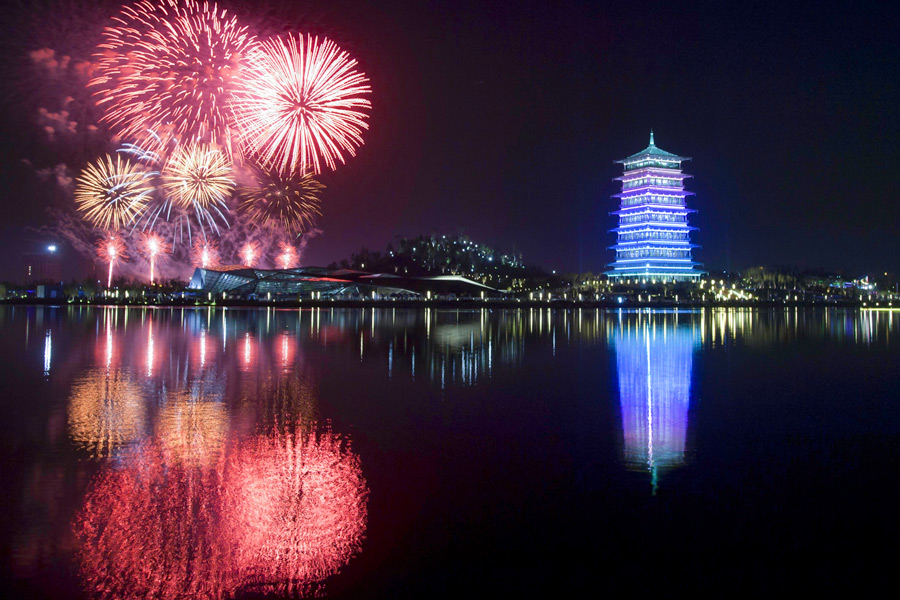
The best time to visit the Muslim Quarter of Xi'an is in spring and autumn, when the streets glow with soft sunlight and the weather is most comfortable. In April-May and September-October, the quarter is especially lively: vendors set out ingredients for local delicacies, and visitors stroll through the quarter’s ancient narrow streets.
In summer, the Muslim Quarter stays vibrant despite the heat. As evening falls, strings of lanterns light up, and night stalls open with refreshing drinks and snacks. In winter, the streets grow quieter and more intimate, with the scent of roasted nuts and caramel pastries drifting through the crisp air. This season offers a chance to enjoy the neighbourhood’s warmth and character without the bustling crowds.
If the season and climate are not your main concern, plan your visit during one of Xi'an’s major national festivals, when the Muslim Quarter comes alive with special traditions:
- Mid-Autumn Festival (September-October) – romantic evenings under a full moon, lit by hanging lanterns, with stalls overflowing with yuebing pastries and nuts.
- Chinese New Year (January-February) – streets decorated with red lanterns, braziers sizzling with meat skewers and sweets, and the rhythmic sounds of drums and gongs.
- Lantern Festival (January-February) – the quarter bathed in golden light, with merchants displaying lanterns inscribed with riddles and performers presenting shadow theatre shows.
- Dragon Boat Festival (May-June) – shops adorned with bundles of zòngzi (rice dumplings wrapped in bamboo leaves) whose aroma fills the air, followed by lively boat races along the waterfront.
- Xi'an Ancient Culture and Art Festival (September) – folk dance performances, craft workshops, and shadow theatre shows held right on the streets.
- Ramadan – Experience the atmosphere each year during the holy month and join locals for Iftar to break the daily fast.
History of the Muslim Quarter of Xi'an
The history of the Muslim Quarter in Xi'an stretches back about 1,300 years. The first Muslims to arrive in the city from Central Asia were Arabs and Persians who traded along the Silk Road. In the 7th and 8th centuries, these merchants travelled widely between East and West, often stopping in the Chinese capital of Chang’an (modern-day Xi'an). Many eventually settled there, forming a close-knit Muslim community centred around a mosque, from which an entire neighbourhood later developed. These immigrants were originally called “da-shi”, but during the Ming and Qing dynasties, they came to be known as Hui.
Along with their religious practices, Arab and Persian settlers brought elements of their native culture to their new home. They introduced clothing styles and musical instruments from their homelands, adapted their traditional cuisine with local ingredients, and shared knowledge of medicine and other sciences.
In the 13th and 14th centuries, when Xi'an was under Mongol rule during the Yuan dynasty, Muslims of Turkic origin also arrived. They assimilated and intermarried with the local population. Over time, all Muslims in Xi'an, regardless of ethnic origin, came to be called Hui, and the traditions of their ancestors blended into a distinctive local culture.
Today, the Muslim Quarter is home to around 60,000 people, more than half of whom are Hui, with the rest primarily Han Chinese, the country’s ethnic majority. All residents speak Standard Mandarin and maintain close community ties, united by shared faith and similar livelihoods. Many families run small businesses in food service or trade in antiques and souvenirs. The history and culture of the Hui and the Muslim Quarter of Xi'an continue to draw visitors from around the globe, forming an essential part of the ancient capital’s identity – a place where the legacy of the Silk Road, Islamic traditions, and the character of old China come together.
Things to Do in the Muslim Quarter
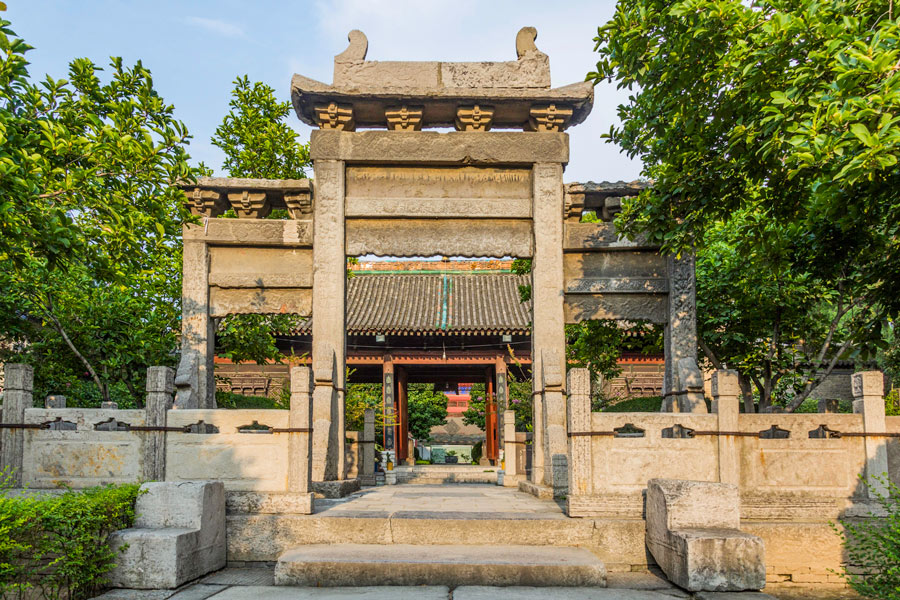
Places to Visit in the Muslim Quarter
The Muslim Quarter features many landmarks that provide insight into both its history and its vibrant present.
The Great Mosque of Xi'an (西安清真大寺) is the main attraction of Xi'an's Muslim Quarter, situated beside the lively Muslim bazaar. Built in 742 during the Tang Dynasty and established by naval admiral Zheng He, who came from a prominent Muslim family, when Xi'an was the Silk Road’s largest hub, it welcomed merchants and craftsmen from across the East. The Muslims who settled here – ancestors of today’s Hui community – formed a close-knit society whose traditions have endured for nearly 13 centuries.
The mosque is renowned for its distinctive architecture, blending Islamic and Chinese styles. Instead of domes and minarets, it features tiered pagodas and tiled roofs, with spacious courtyards shaded by greenery. Decorative elements include plant motifs and Arabic calligraphy, while the prayer hall is adorned with hundreds of Ming and Qing dynasty ornaments. Aligned precisely toward Mecca, the mosque remains an active religious centre. Visitors are welcome to explore its courtyards, though entry to the prayer hall is reserved for Muslims.
The Drum Tower (鼓楼) rises above Zhengxue Street as one of Xi’an’s most iconic landmarks. Together with the Bell Tower to the east, it forms a striking architectural pair that dominates the historic heart of the city. Like its “sister” tower, the Drum Tower once marked the passage of time for the city’s residents.
Standing on a massive stone base, the Drum Tower is crowned with a multi-tiered roof, its graceful eaves and colourful tiles reaching a height of 34 metres (111.55 feet). Visitors can enjoy theatrical performances inside and, for a small fee, strike the ancient drum suspended at the exit three times. From the upper gallery, the views over central Xi'an and its lively neighbourhoods are particularly memorable.
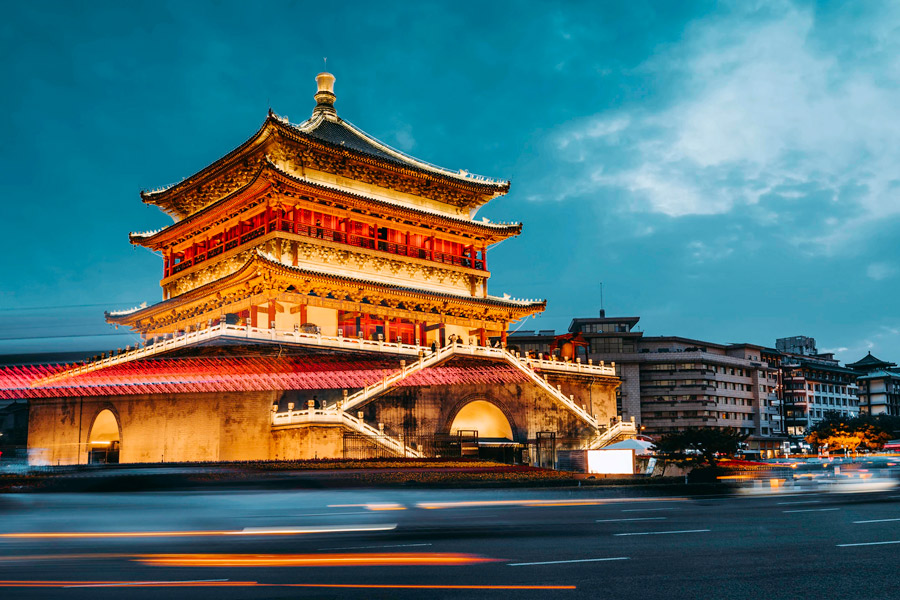
The Bell Tower (西安钟楼) is another legendary monument, regarded as the largest bell tower in China. It once marked the geographical centre of ancient Xi’an and continues to hold special cultural significance. Its main feature is a giant bell modelled after the renowned Jingyun Bell of the Tang Dynasty, complete with replicas of its original patterns and inscriptions. The tower offers a different impression by day and night, but its graceful silhouette is especially captivating in the evening, when lighting highlights its elegant lines.
The Muslim Bazaar Area is the premier destination for purchasing souvenirs in the Muslim Quarter and for engaging with the locals. Located behind the Drum Tower and surrounding the Grand Mosque, it serves as an ideal location for acquiring folk art, especially from local artists. There, a variety of intriguing items await your discovery, including Xifu embroidery, cloth dolls, Fengxiang clay sculptures, Gongdao cups, Meihua teapots, Shaanxi-themed tea sets and porcelain, traditional Hanfu clothing, Tibetan thangkas, and Uyghur embroidery.
Nearby Attractions
The Xi'an City God Temple (西安都城隍庙) is one of the most significant and revered Taoist temples in northwestern China, located on West Avenue near the Muslim Quarter. It is the largest shrine in the Shaanxi Province dedicated to the guardian deity of the city and once held authority over similar temples across the northwestern provinces.
Founded in 1387 during the reign of Emperor Hongwu of the Ming Dynasty, the temple’s history mirrors the turbulence of Xi’an itself. Fires and destruction left it in ruins multiple times. Restored in the 18th century, it suffered again in the 20th century from Japanese bombings, which destroyed priceless scrolls, relics, and rare musical scores preserved there for centuries. In 2003, the temple was returned to the Taoist community, and today it welcomes both worshippers and visitors, offering a window into Xi’an’s enduring spiritual heritage.
Entertainment, Parks, and Shopping in Xi'an's Muslim Quarter

Entertainment
A Tasty Spectacle: The Muslim Quarter’s Street Food Show
In the Muslim Quarter, street food preparation is as much a performance as a meal. As you stroll along the main streets, vendors compete for attention with lively and theatrical cooking displays. Chefs twirl noodles high into the air before plunging them into steaming, fragrant broth. Nearby, machines grind chilli peppers and dried garlic for hearty soups, while grill masters lower massive breaded squid into sizzling oil. Two strong men pound dough for flatbreads with heavy wooden mallets, filling the air with rhythmic sounds. These inventive methods and time-honoured dramatic cooking techniques transform a simple food purchase into a captivating culinary attraction.
A World of Shadows and Music: The Carved Puppet Show
For a taste of authentic Shaanxi folk art, visit the Hua Yin Laoqiang shadow theatre at Gao’s Grand Courtyard. As night falls, the glow of lanterns animates delicate, hand-painted figures mounted on bamboo sticks. Their graceful silhouettes glide across the screen, accompanied by the sharp, evocative sounds of traditional music. These shadow plays bring to life centuries-old tales of love, heroism, and palace intrigue, creating an enchanting evening experience.
Where to Watch: Gao’s Grand Courtyard, No. 144 Beiyuanmen Street
Opening Hours: 09:00–22:00
Shadow Play Performances: 10:00–21:00
Parks in the Muslim Quarter of Xi'an
Just a few minutes’ walk from the Muslim Quarter lies Lianhu Park (莲湖公园), a shady retreat with winding walking paths and two peaceful lakes. In addition to strolling or enjoying a picnic, visitors can try go-karting, test their aim at a shooting gallery, take children to play on various rides, or rent a catamaran for a relaxing ride on the water.
Shopping in the Muslim Quarter of Xi'an
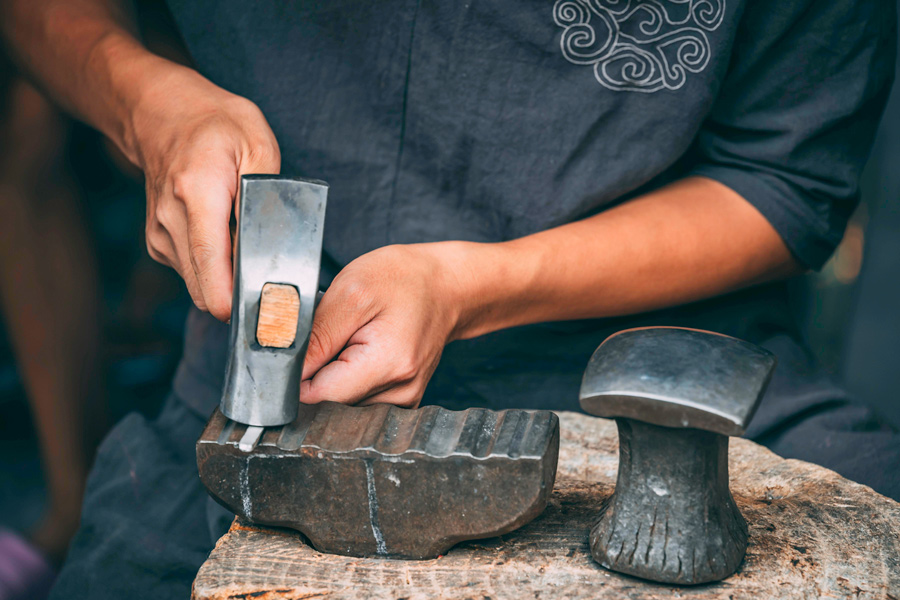
The Muslim Bazaar and Beiyuanmen Street (北院门) form the vibrant heart of the Muslim Quarter, alive with the flavours of Xi’an cuisine and the bustle of traditional trade. Visitors flock here not only to sample local delicacies but also to pick up distinctive handmade keepsakes crafted by local artisans.
One of the most striking mementos is the traditional flat hinged doll, carved from wood and painted in vivid colours. Inspired by the ancient art of Chinese shadow theatre, these figures are designed as decorative souvenirs rather than performance props. Their movable joints make them appear almost animated in your hands. Common motifs include fierce warriors, wise elders, and animals of the Lunar calendar, each imbued with symbolic meaning. These colourful dolls perfectly capture the spirit of old Xi’an. Other remarkable traditional handicrafts include Ma Shao masks.
Another popular find is the archaeological toy set featuring miniature Terracotta Army warriors. Hidden inside a soft clay block, the figures – complete with detailed armour and horses – can be unearthed with a small spatula and brush included in the kit. Simply moisten the clay, and your own miniature excavation begins. Each piece measures about 12 centimetres (4.96 inches) and offers a playful way to connect with Xi’an’s history. This unique gift brings both learning and fun, especially when shared with family or friends.
For those with a sweet tooth, the caramelised walnuts and peanuts (琥珀核桃 and 琥珀花生) are a must. Roasted and glazed in a rich amber caramel, they are delicious on their own or as a topping for porridge, ice cream, or other desserts. Sold by weight, they are easily packed in gift bags or boxes – a delightful edible souvenir with a long shelf life.
Also popular are colourful paper miniatures designed for shadow theatre. Cut from thick paper and mounted on slender wooden sticks, they often depict Xi’an’s most iconic landmarks: the Drum and Bell Towers, the Big and Small Wild Goose Pagodas, the city wall gates, and the Terracotta Army. Lightweight and easy to carry, these vibrant figures make charming decorations, especially for lovers of history and traditional culture.
For something truly special, step into one of the Quarter’s silver shops. You may spot artisans at work, rhythmically hammering intricate patterns into metal, sometimes women adorned with elaborate silver headdresses to draw attention. Inside the shops, counters gleam with jewellery in a dazzling array of designs, offering a meaningful and elegant keepsake from Xi’an.
Food in the Muslim Quarter
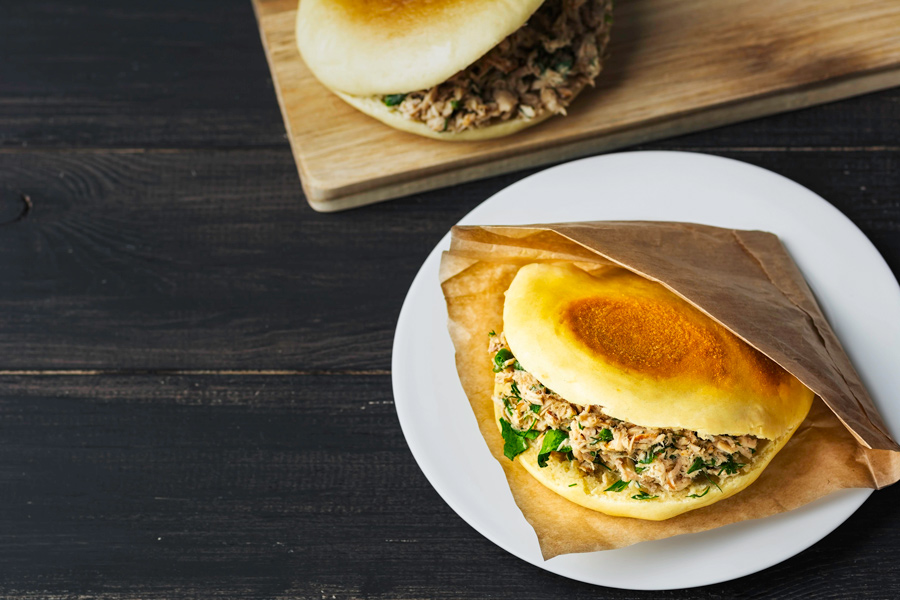
Today, Xi'an's Muslim Quarter is renowned across China as a gastronomic paradise – a place where traditional recipes, carefully passed down through generations, have developed a distinctive local flavour. Over time, a recognisable menu has taken shape here, centred on lamb and beef, hearty broths, flatbreads, nuts, and desserts infused with the aromas of rose and coconut.
Must-Try Halal Street Food
The streets and small teahouses of the Muslim Quarter offer hundreds of tempting snacks, dishes, and sweets. Here are some of the specialities that make this neighbourhood a culinary destination in Xi’an:
Yangrou Paomo (泡馍) – This hearty lamb stew is a true icon of Xi’an cuisine. A steaming bowl combines tender lamb, noodles, green onions, garlic, coriander, and fragrant spices. Traditionally, diners crumble a soft, crispy steamed bun into the broth before handing it back to the chef, who adds noodles, chilli oil, and pickled garlic. Rich and filling, Yangrou Paomo is perfect for restoring energy after hours of exploring.
Jing Gao (镜糕) – Known as “wooden cage mirror cake”, this delicate dessert is made from sticky rice steamed in small wooden moulds, red and honey dates, and red kidney beans. Once soft and chewy, the rice cakes are topped with sugar, coconut flakes, crushed nuts, and pink jam. The round cakes gleam like tiny mirrors and melt gently in the mouth, leaving a subtle honeyed sweetness.
Suantang Shuijiao (酸汤水饺) – These dumplings are served in a thick, tangy broth that gives the dish its distinctive flavour. The broth combines dried shrimp, fried sesame seeds, coriander, scallions, sesame and chicken oil, beef fat, soy sauce, and sweet vinegar, finished with a spoonful of chilli oil. Traditionally filled with beef or lamb, the dumplings absorb the sour-and-spicy broth, creating a bold, layered taste.
Youcha Mahua (油茶麻花) – A beloved breakfast dish in Xi’an’s Muslim Quarter. Crispy, golden dough twists (máhuā) are served with hot, thick “oil tea” made from roasted peanuts and almonds. The nutty drink pairs beautifully with the sweet crunch of the dough twists, making a hearty morning treat.
Wei Youyu Si (煨鱿鱼丝) – Thin strips of squid, simmered slowly with chicken, absorb the deep flavours of the broth during hours of cooking. The result is a rich, slightly sticky soup with tender squid and a layered taste of both land and sea. Nutritious and high in protein, it’s as wholesome as it is flavourful.
Meat Skewers – One of the Muslim Quarter’s most popular snacks. The alleys are filled with the sound of sizzling meat and the aroma of spices and smoke. Skewers of lamb, beef, squid, and even chicken hearts are seasoned with cumin, chilli, black pepper, and salt, then grilled over charcoal until golden and fragrant.
Uighur Flatbread (Nángbĭng) – These golden, sesame-sprinkled breads often feature intricate designs baked into their crusts. Crisp on the outside with a tender, lightly spiced crumb, they are perfect with meat dishes, soups, or as a satisfying snack on the go.
Fried Persimmon Cakes (Shi Zi Bing) – Made from ripe persimmons grown in nearby Lintong County, these patties are made of liquefied persimmons mixed with wheat flour and sometimes with sugar, then fried until golden brown. Their warm, fruity aroma and soft, slightly sticky texture offer a delightful blend of caramel and persimmon flavour.
Roujiamo (肉夹馍, Chinese Hamburger): A popular local delicacy in the Muslim Quarter, this dish features spiced meat encased in flatbread, making it ideal for a quick snack.
Restaurants
Here are some tried-and-true spots in Xi’an’s Muslim Quarter, known for their quality dishes and authentic flavours:
Biang Biang Mian – This restaurant is famed for its signature wide Biang Biang Mian noodles. Before stepping inside, pause at the entrance to watch chefs skilfully stretch and slap the dough against the table, producing the loud “biang” sound that gave the dish its name. The long, ribbon-like noodles are as striking to see as they are satisfying to eat. A cosy interior, spotless surroundings, and quick service make dining here a pleasure.
Location: 80 Nanyuanmen, Beilin, Xi'an.
Lao Bai Jia (老白家泡馍) – A favourite among locals, this eatery specialises in hearty meat broth with vegetables, herbs, and fragrant flatbread. The dish comes with generous servings of beef, stewed mushrooms, and glass noodles. For the perfect finish, enjoy a cup of hot green tea – especially comforting in the colder months.
Location: 178 Beiyuanmen, Zhonglou Shopping District, Lianhu District, Xi'an.
Hui Wen Ren Jia (Huiwen Home) (回文人家) – A welcoming restaurant with a varied menu that caters to both meat lovers and vegetarians. Popular choices include rich broths brimming with ingredients, Biang Biang Mian noodles, and traditional Chinese dumplings. With two floors and ample seating, it’s a convenient choice for groups and families.
Location: 7W7V+2GW, Beiyuanmen, Lianhu District, Xi'an.
How to Get to the Muslim Quarter of Xi'an

By Metro
The easiest way to reach the Muslim Quarter is by metro. Take Metro Line 2 or Line 6 and get off at Bell Tower Station (Zhonglou/钟楼). Use Exit B and head northwest toward the Drum Tower. From there, walk along Beiyuanmen Street, the main thoroughfare of the Muslim Quarter. It’s just a 5-minute walk to the heart of the district, where you’ll find street food stalls, souvenir shops, and historic landmarks.
By Bus
Several city buses stop near the Muslim Quarter, with Bell Tower (Zhonglou/钟楼) serving as the most convenient hub.
- Bell Tower South Stop: Buses 6, 11, 16, 26, 29, 35, 46, 208, 209, 603, 605, 608, 609, 616
- Bell Tower West Stop: Buses 15, 32, 43, 45, 201, 215, 218, 221, 222, 251, 252, 286, 300, 604, 611, 612, 618, 622
- Bell Tower North Stop: Buses 4, 12, 37, 229, 235, 600, 618
From any of these stops, follow signs toward the Drum Tower and continue into Beiyuanmen Street, the gateway to the Muslim Quarter.
Languages Spoken in the Muslim Quarter of Xi'an

The primary language spoken in the Muslim Quarter, as in the rest of Xi’an, is Standard Mandarin (Putonghua). It is used in shops, cafés, and tourist areas throughout the district. In everyday conversation, many locals speak the Guanzhong dialect, a regional variety specific to Shaanxi Province, which features a distinct accent and vocabulary that is generally understandable to Mandarin speakers.
Within the Hui community, which makes up a large portion of the Muslim Quarter’s population, Putonghua is also commonly spoken. However, you may occasionally hear words of Arabic or Persian origin, especially those related to religion or traditional cuisine, adding unique character to local speech.
English is not widely spoken in the area. Most vendors in markets, souvenir shops, and food stalls speak only Chinese, though some may know a few basic English phrases. To ease communication, it’s helpful to carry key addresses, dish names, or items of interest written in Chinese characters in advance.
Currency
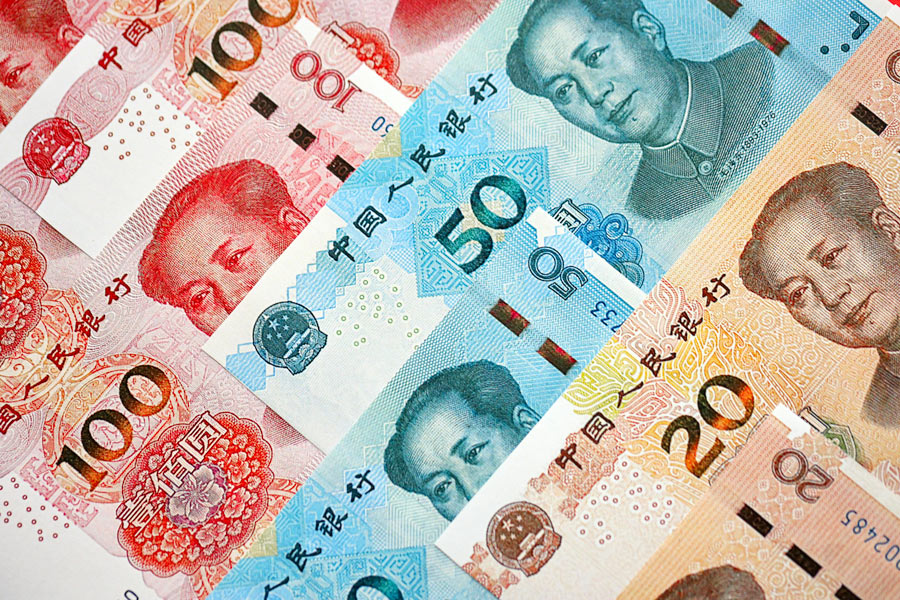
In the Muslim Quarter, as in the rest of China, transactions are made in yuan (CNY/RMB). Most street vendors, souvenir stalls, and small eateries operate on a cash-only basis, so it’s a good idea to carry small denominations (5 to 20 yuan) to make purchases easier and avoid issues with change.
ATMs are available near the main entrances to the Quarter, on nearby streets, and around hotels or large stores. While international credit cards (Visa, MasterCard) may be accepted at major restaurants or supermarkets outside the Quarter, they are rarely used within the neighbourhood itself.
Mobile payments such as Alipay and WeChat Pay are becoming increasingly common and can be linked to foreign bank cards. However, to avoid any inconvenience, it’s best to carry cash as a backup when visiting the area.
Security
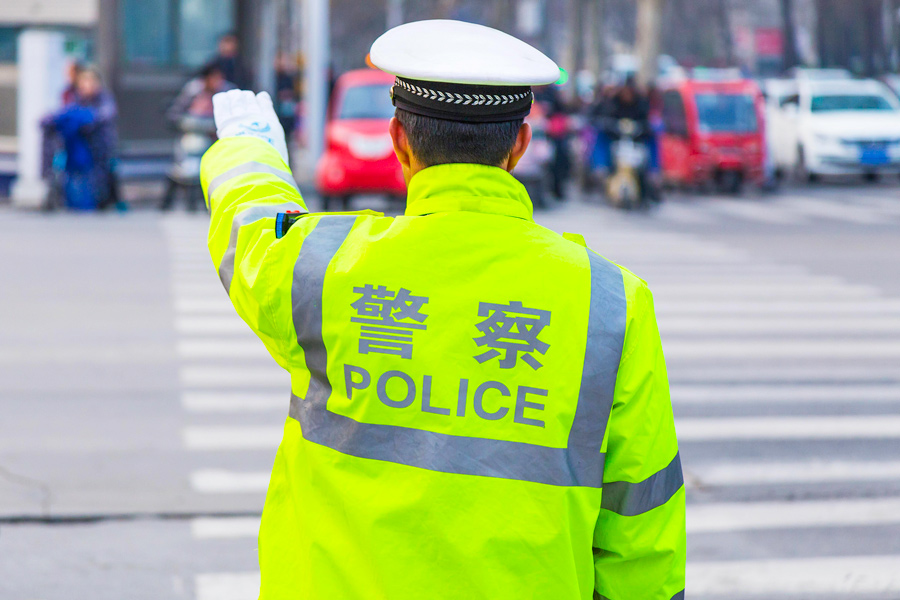
The Muslim Quarter of Xi'an is a lively yet generally safe area, where walking even after dark is considered secure. The neighbourhood is regularly patrolled by police, and locals are welcoming toward tourists. However, due to the heavy foot traffic on main streets, it’s important to stay alert and watch your belongings – pickpocketing can occur in crowded areas. Keep your valuables, such as documents, money, and phones, in inner pockets or a secure belt bag.
In narrow lanes or during peak hours, be cautious of motorcycles and electric scooters, which often pass through pedestrian areas without slowing down.
While the overall sanitary risk is low, choose busy food stalls with a good reputation and fresh ingredients when sampling street food. Always drink bottled water to avoid potential stomach issues. Otherwise, follow standard travel precautions and enjoy the vibrant atmosphere of this unique district.
Travel Tips: Notes for the Curious Traveller
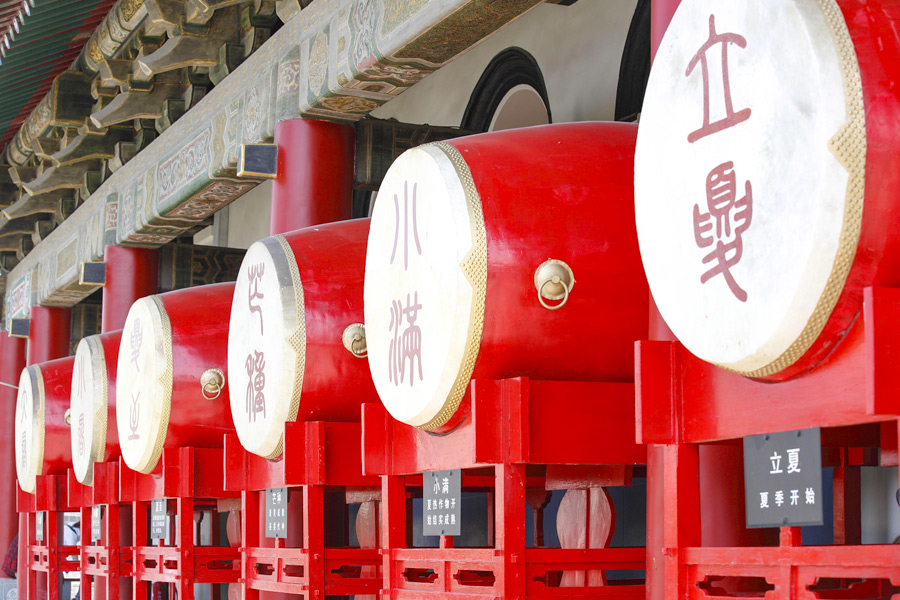
Go off the beaten track. Don’t limit yourself to the main commercial streets – the most authentic moments await in the quieter courtyards and hidden lanes, where the Hui community continues its daily life. Here, you’ll find historic mosques, watch locals shop and cook, and pick up snacks from street vendors operating out of three-wheeled tuk-tuks – often at better prices than on the main road.
Be bold with your palate. Don’t hesitate to try unfamiliar dishes – even if the names are hard to decipher. The Muslim Quarter offers a wide variety of flavours that reflect both Chinese and Islamic culinary traditions. You may also uncover rare finds in its souvenir shops, from traditional crafts to unusual local inventions.
Visit in the evening. As dusk falls, the quarter transforms. Strings of lights illuminate the streets, food stalls glow under lanterns, and street musicians add to the festive atmosphere.
Don’t be shy about bargaining. Especially in the souvenir markets, haggling is expected and even encouraged. It’s part of the local shopping culture and handled with good humour.
Dress modestly when visiting a mosque. Ensure that your clothing covers your arms, legs, and chest, and women should wear a headscarf. Remember to remove your shoes before entering a mosque to show respect for the sacred space.
A visit to the Muslim Quarter is more than a tour of one of Xi’an’s most colourful neighbourhoods – it’s an invitation to experience the living legacy of the Silk Road. Around every corner, you’ll find new sights, scents, and sounds that create lasting memories. Your time here will become an essential part of understanding Xi’an’s rhythm, spirit, and historical depth.

